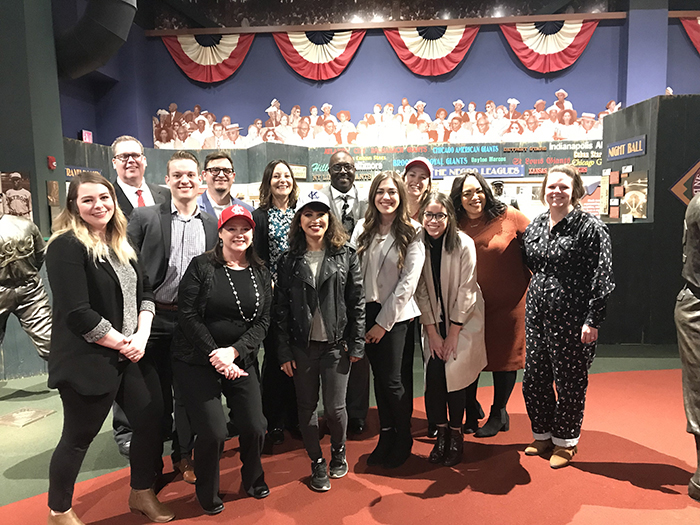Marketing class helping Negro Leagues Baseball Museum share its unique story

LAWRENCE — While most college students were far away from campuses and classrooms, spending time with family or recovering from the stress of finals, a dedicated group of University of Kansas students spent winter break evenings in a classroom talking baseball. More specifically, they developed marketing plans to help share the stories of a unique aspect of the sport’s history.
 KU’s Integrated Marketing Communications master’s program capstone class is developing resources for the Negro Leagues Baseball Museum in Kansas City, Missouri. The students, all working adults taking classes at KU’s Edwards Campus, put together multifaceted, research-based marketing plans for the museum in an intensive, three-week pilot course. Their work will help the museum develop plans to attract new visitors, grow its current donor base and conduct educational outreach.
KU’s Integrated Marketing Communications master’s program capstone class is developing resources for the Negro Leagues Baseball Museum in Kansas City, Missouri. The students, all working adults taking classes at KU’s Edwards Campus, put together multifaceted, research-based marketing plans for the museum in an intensive, three-week pilot course. Their work will help the museum develop plans to attract new visitors, grow its current donor base and conduct educational outreach.
“We started noticing trends in higher education recently featuring travel away from campus as an immersive part of the learning experience. We decided to really focus on that time-shortened, experiential aspect and try a pilot capstone course over the winter break,” said Angie Hendershot, professor of the practice in KU's William Allen White School of Journalism & Mass Communications. “Working adult learners often value getting things done more quickly. And in the professional world, you don’t get a 16-week semester to put a marketing plan together.”
The majority of students in the class completed another course in the fall in which they performed market research for the museum. That class analyzed industry trends, market data, consumer perceptions and behavior relevant to driving the goals of the organization. The museum tells the story and preserves the history of a baseball league formed to give a home to black players denied the opportunity to play in the major leagues from the late 19th century until Jackie Robinson broke the color barrier in 1947.
The students are helping the museum share its sports, history, social exhibitions and programming in a number of ways. The class divided into three groups to focus on identifying and attracting visitors, growing membership and sponsorships, and educational outreach to youth audiences.
Students started in mid-December after presenting their initial research to Bob Kendrick, museum director, on the “Field of Legends.” The class has taken regular visits to the museum and set up shop in Kansas City’s famous 18th and Vine district to continue their work. This week, they’ll make their final presentations with strategies and ideas for attracting new visitors and refining marketing technology to understand better who comes to the museum; find ways to enhance sponsorships, make membership more valuable and cultivate lasting donor partnerships; and increase outreach to educational organizations and youth.
There is no shortage of businesses or potential partners for whom such a class could develop marketing plans, but the Negro Leagues Baseball Museum was a natural fit.
“We look for course clients where we can contribute to the community while giving students top-notch professional development experiences,” Hendershot said. “This was a chance to serve a locally based organization that is also a national treasure. Our students deepen their cultural competency while being challenged to develop creative ideas that drive growth for our client.”
In addition to developing a marketing plan for a worthy organization and giving students invaluable experience, Hendershot and colleague Matt Tidwell, IMC program director and lecturer in the journalism school, are evaluating the class and what can be learned from its unique structure. Intensive courses are a growing trend in higher education, and they will analyze lessons learned, students’ satisfaction and other feedback to share in academic conference presentations about immersive and experiential learning.
Throughout the course, students used video conferencing technology to consult with communications professionals from the National Baseball Hall of Fame in Cooperstown, New York, and project management software to collaborate on work even when they weren’t together in class.
“These students have given up a lot of their lives. They work full-time and come here in the evenings four nights a week,” Hendershot said. “It’s been such a pleasure to see their work come together for a great client like the Negro Leagues Baseball Museum.”
The students have brought their own unique expertise and skills to the fore, implementing ideas for how to expand marketing technology and identify target audiences. For example, a bilingual student has leveraged niche marketing insights for Hispanic outreach, given the close cooperation between the league and Hispanic players and the welcome black players received in Latin America. Two former teachers in the class offered their educational experience to the outreach to schools.
“If we do our jobs right, we’ll give the Negro Leagues Baseball Museum some useful ideas that they can put in place for better marketing now and in the years to come as they will soon celebrate 100 years since the Negro Leagues were created in Kansas City,” Hendershot said.
Photo: Integrated marketing communications students in Professor Angie Hendershot's class presented their findings to Negro Leagues Baseball Museum President Bob Kendrick on the museum's "Field of Legends." The students spent winter break developing marketing plans for the museum based on market research that will help the museum expand its reach, donor base and educational outreach. Credit: Matt Tidwell